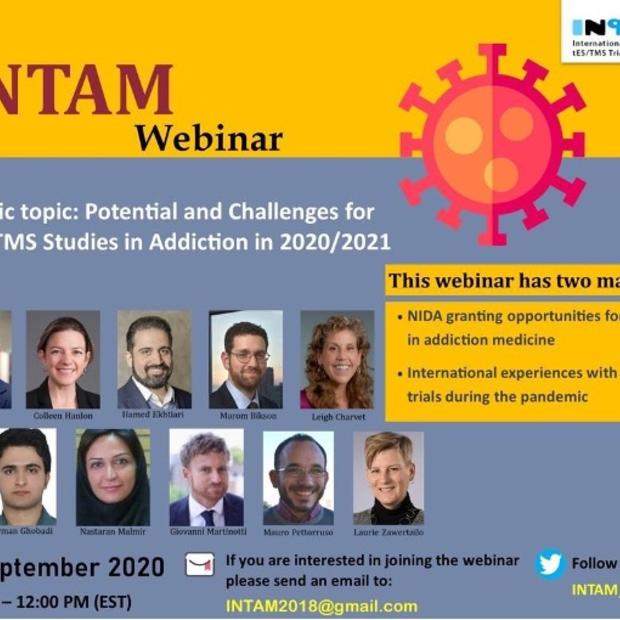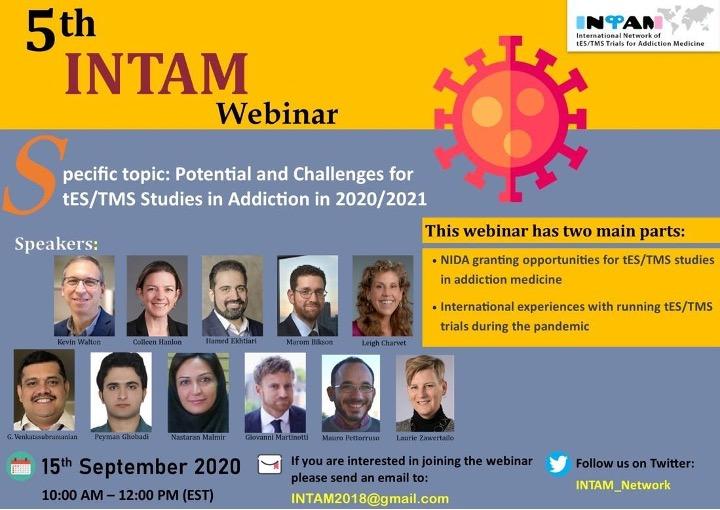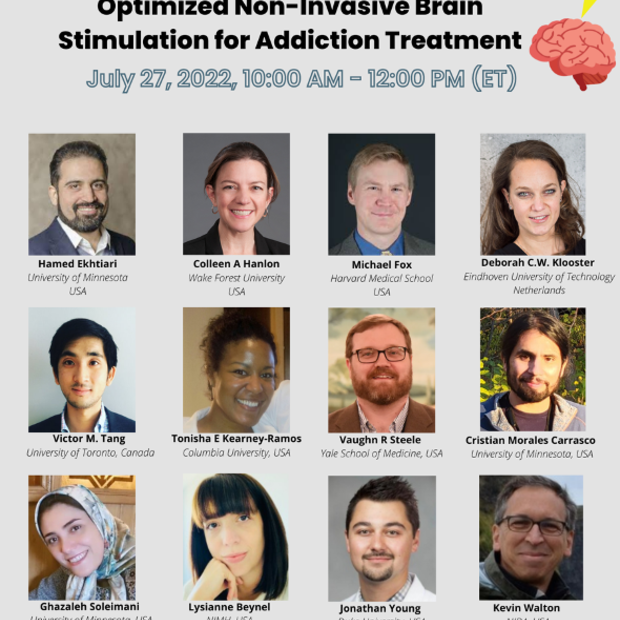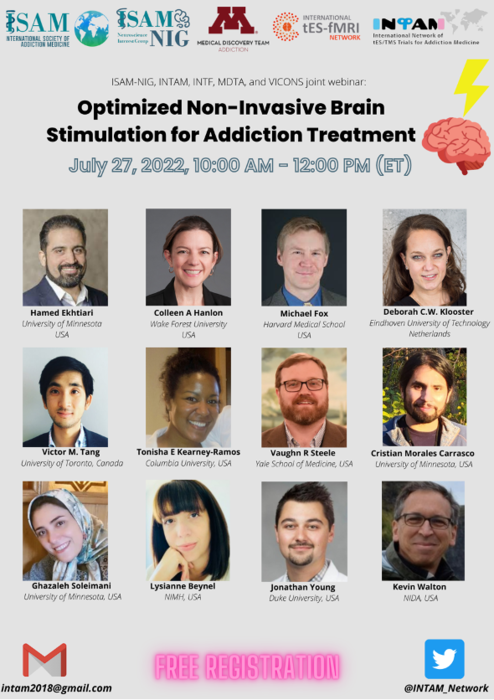International Network of tES/TMS Trials for Addiction Medicine- INTAM
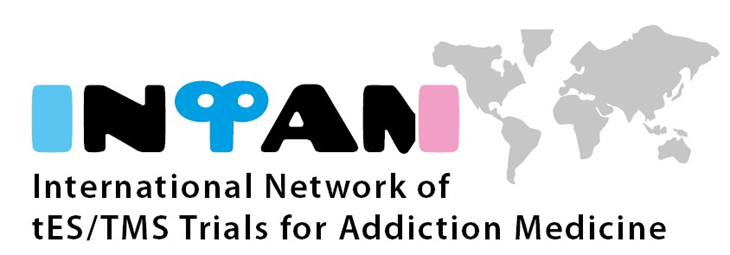
International Network of tES/TMS Trials for Addiction Medicine
The International Network of tES/TEMS Trials for Addiction Medicine (INTAM) is a virtual collaborative network in science (VICONS) which is an international collaborative group of investigators with expertise in neuromodulation and addiction research. The leadership core consists of 14 experts in the field (steering committee), and the group has grown to over 80 members from research centers and labs across the globe. The aim of INTAM is to provide a framework for future research and propose guidelines for best practices in non-invasive brain stimulation substance use disorder research.
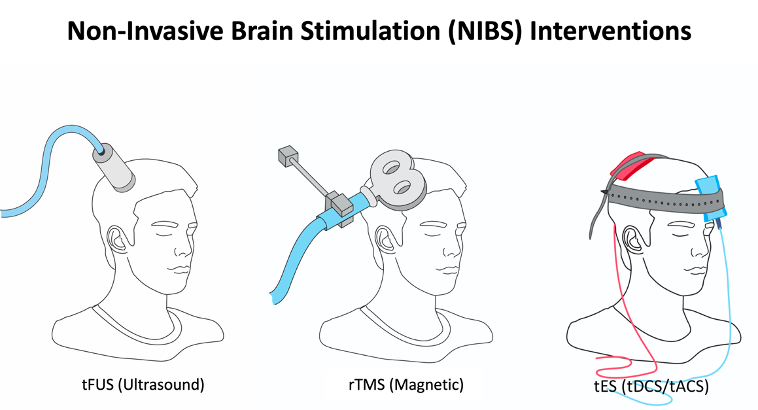
A brief overview of non-invasive brain stimulation for substance use disorders
A non-invasive brain modulation is an innovative approach in the treatment of substance use disorders (SUDs) that has gained increasing interest in recent years. This technique involves the use of non-invasive methods to modulate brain activity in specific circuits of the brain associated with drug use and addiction.
There are several types of non-invasive brain stimulation techniques, including transcranial magnetic stimulation (TMS), transcranial electrical stimulation (tES), and transcranial focused ultrasound stimulation (tFUS). These techniques work by applying magnetic or electrical currents or ultrasound waves to the brain, which can activate or inhibit certain neural circuits.
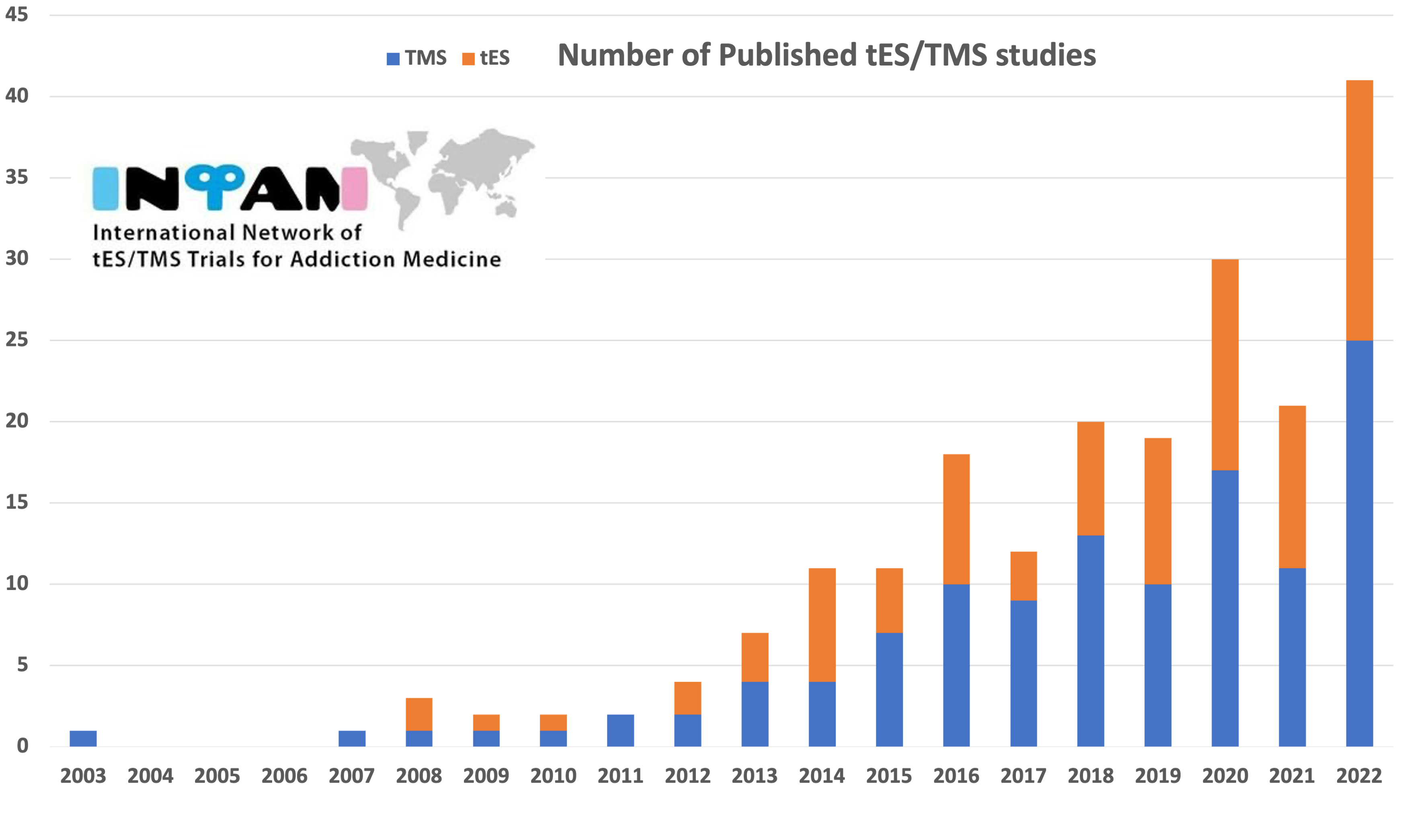
There are 86 tES and 119 TMS published randomized clinical trials in the field of addiction treatment till the end of 2022 based on the INTAM live systematic review

There are over 21 countries involved in developing a body of evidence in using TMS and tES in addiction medicine
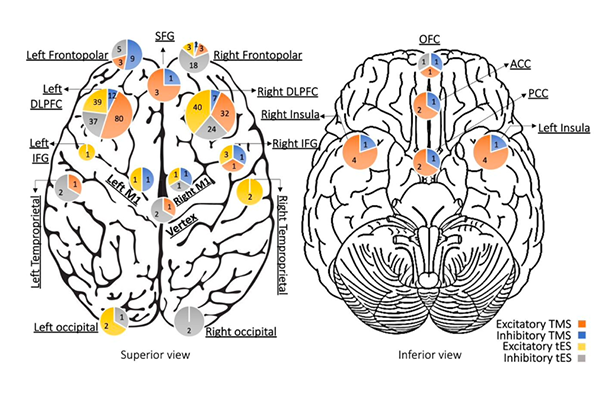
Current publications in the field targeted various brain areas with multiple different methods.
To address the variability in methods and outcome measures across non-invasive brain modulation trials for SUDs across the world, an international collaborative group of investigators with expertise in neuromodulation and addiction research (INTAM) was formed. The group has proposed guidelines for best practices in non-invasive brain stimulation SUD research and is working to accelerate the translation of basic neuroscience findings into advanced neuromodulation tools for clinical practice.
What is INTAM?
The International Network of TMS/tES trials for Addiction Medicine (INTAM) was formed in response to the need for a more standardized approach to non-invasive brain stimulation research in substance use disorders (SUDs). The variability in methods and outcome measures across trials has made it difficult to reproduce results and interpret findings, slowing down progress in the field.
INTAM is a VICONS (virtual collaborative network in science) which is an international collaborative group of investigators with expertise in neuromodulation and addiction research. The leadership core consists of 14 experts in the field (steering committee), and the group has grown to over 80 members from research centers and labs across the globe. The aim of INTAM is to provide a framework for future research and propose guidelines for best practices in non-invasive brain stimulation SUD research.
INTAM has already made significant progress toward achieving these goals. The group has held webinars and joint meetings and published a consensus paper with over 70 authors from 17 different countries proposing guidelines for best practices in non-invasive brain stimulation SUD research (INTAM first consensus paper). These guidelines aim to bridge current knowledge gaps and accelerate progress in the field.
INTAM has also collaborated with other organizations, such as the NYC Neuromodulation Conference, and has published a guideline on the impact of COVID-19 on brain stimulation labs/studies/researchers across the world (COVID-19 guideline).
By bringing together experts in the field and providing a standardized approach to research, INTAM aims to accelerate the translation of basic neuroscience findings into advanced neuromodulation tools for clinical practice, ultimately improving outcomes for individuals with SUDs.
INTAM Webinars
INTAM has held a series of six webinars focused on different aspects of non-invasive brain stimulation for substance use disorders. These webinars were led by experts in the field and provided an opportunity for participants to learn about the latest research and developments in the field.
The topics covered in the webinars included:
- Introduction to non-invasive brain stimulation for addiction medicine
- Imaging techniques for understanding the mechanisms of non-invasive brain stimulation
- Optimizing non-invasive brain stimulation protocols for substance use disorders
- Clinical trials and regulatory issues in non-invasive brain stimulation
- Long-term effects and ethical considerations of non-invasive brain stimulation for substance use disorders
All of these webinars were recorded and are available for viewing on the INTAM YouTube channel. These recordings provide a valuable resource for researchers, clinicians, and anyone interested in learning more about non-invasive brain stimulation for substance use disorders.
PAST WEBINARS:
- INTAM 1st webinar: International Network of tES/TMS Trials for Addiction Medicine. LINK
- INTAM 2nd webinar: January 24th 2019 LINK
- INTAM 3rd webinar: April 11th 2019 “How to deal with trials with negative results” LINK
- INTAM 4th webinar: February 4th 2021“How to combine brain stimulation with neuroimaging: Concurrent tES-fMRI”: LINK
- INTAM 5th webinar: September 15th 2020 “Guidelines and experiences for tES/TMS clinical services and research through the COVID-19 pandemic” LINK
INTAM Meetings
INTAM organizes multiple meetings annually in parallel to the major relevant scientific meetings including but not limited to CPDD, SOBP, OHBM and ACNP. To be informed about the upcoming meetings, please join the INTAM WhatsApp group through this link (https://chat.whatsapp.com/G13VLRLc5td8a27FWtcsH8 ).
As an example, INTAM has held two joint meetings in parallel with other conferences to promote collaboration and knowledge sharing across the field. The first joint meeting was held in August 2018 in parallel to the New York City Neuromodulation Meeting. The second joint meeting was held in February 2019 in parallel to the 3rd International Brain Stimulation Conference in Vancouver.
During these joint meetings, INTAM members had the opportunity to discuss current gaps in knowledge and to propose strategies for addressing these gaps. These meetings provided a valuable forum for researchers and clinicians working in the field of non-invasive brain stimulation for substance use disorders to share their ideas and findings, to network with colleagues, and to learn about the latest advances in the field.
The joint meetings were also an opportunity for INTAM members to present their work to a wider audience and to raise awareness about the importance of non-invasive brain stimulation for substance use disorders. By collaborating with other conferences, INTAM was able to reach a broader audience and to build partnerships with other organizations working in related fields.
Overall, the joint meetings were an important step forward for the field of non-invasive brain stimulation for substance use disorders, and they helped to establish INTAM as a key player in this area of research.
INTAM Consensus Papers
The consensus paper proposed guidelines for best practices in non-invasive brain stimulation for substance use disorder (SUD) research. The first paper was published in Neuroscience and Biobehavioral Reviews in 2019 and was authored by more than 70 experts from 17 different countries around the world.
The consensus proposed in the paper is designed to address the challenges facing the field of non-invasive brain stimulation for SUD research, such as the variability in methods and outcome measures across different trials, small sample sizes, lack of rigorous control conditions, and insufficient blinding.
The paper outlines several key recommendations, including the need for larger sample sizes, the use of rigorous control conditions, and the use of standardized outcome measures. The paper also emphasizes the importance of transparency in reporting methods and results, and the need for independent replication of findings.
The publication of this consensus paper was an important milestone for the field of non-invasive brain stimulation for SUD research, as it provided a framework for future research and established a set of best practices that could help to ensure the reliability and reproducibility of research findings. The paper has been cited nearly 40 times in less than a year, demonstrating its impact and influence on the field.
The second INTAM consensus paper is under process. If you have a significant contribution to the published body of evidence, You are welcome to contact INTAM email address and nominate yourself to contribute as one of the authors (intam2018@gmail.com).
Other Guidelines/Consensus Statements
INTAM is interested in contributing to the global efforts for transparent and open science with developing guidelines, technical reports, consensus statements and shared protocols.
As an example, INTAM organized a panel on the topic of "COVID-19 and brain stimulation labs/studies/researchers across the world: Sharing experiences, difficulties, and best practices" during the NYC Neuromodulation 2020 conference. The panel was chaired by Hamed Ekhtiari and Marom Bikson and included twelve speakers from different countries.
The panel discussed the impact of the COVID-19 pandemic on brain stimulation labs, studies, and researchers around the world. They identified the challenges posed by the pandemic, such as disruptions to research activities, the need for remote data collection, and the impact on funding and collaborations.
The panel also discussed the best practices that could help researchers navigate these challenges, such as using remote data collection methods, adapting study designs, and collaborating with other labs to share resources and expertise.
Following the panel, the chairs and several colleagues collaborated on a document outlining the best practices discussed during the panel. The resulting guideline is a 68-page document authored by 42 experts and was published in Brain Stimulation. The guideline provides practical recommendations for researchers on how to conduct brain stimulation research during the pandemic, while also addressing the ethical and safety considerations that arise during this time., Here, you can find the published paper.
INTAM also had a fruitful collaboration with the International Network of tES fMRI (INTF) and published a comprehensive checklist to guide researchers in running concurrent tES-fMRI trials. This collaboration represents INTAM's commitment to collaborating with other networks and organizations to advance the field of non-invasive brain stimulation for substance use disorders.
The checklist titled "A checklist for assessing the methodological quality of concurrent tES-fMRI studies (ContES checklist): a consensus study and statement" published in the journal of Nature Protocols in 2021 presents a consensus-based checklist for evaluating the methodological quality of concurrent transcranial electrical stimulation-functional magnetic resonance imaging (tES-fMRI) studies. The checklist includes ten items covering various aspects of study design, execution, and reporting, and is intended to improve the rigor and transparency of tES-fMRI research. The authors emphasize the importance of using the ContES checklist to enhance the credibility and reproducibility of tES-fMRI findings and suggest its adoption as a standard tool for peer reviewers and researchers in the field.
Here, you can find the published paper.
INTAM Members
INTAM has more than 80 members from research centers and labs across the globe. These members come from diverse backgrounds and expertise, including clinical psychiatrists, neuroscientists, physicists, and psychologists, among others.
- Tifei Yuan Lab, Shanghai Mental Health Institute, Shanghai, China, (Lab/PI Page: https://www.shsmu.edu.cn/english/info/1341/2913.htm)(Lab/PI Email: ytf0707@126.com)
- Social, Cognitive and Affective Neuroscience Unit, Faculty of Psychology, University of Vienna, https://scan-psy.univie.ac.at, Head: CLaus Lamm, claus.lamm@univie.ac.at
- Vincent Van Waes, Laboratoire de Recherches Intégratives en Neurosciences et Psychologie Cognitive - LINC, University of Franche-Comté, Besançon, France (Lab/PI Page: https://neurosciences.univ-fcomte.fr/) (Lab/PI Email: vincent.van_waes@univ-fcomte.fr)
- Xiaochu Zhang Lab, University of Science and Technology of China, Anhui, China, (Lab/PI page: Cognitive Neuropsychology Laboratory (ustc.edu.cn))(Lab/PI Email: zxcustc@ustc.edu.cn)
- Michael A. Nitsche, Dept. Psychology and Neurosciences, Leibniz Research Centre for Working Environment and Human Factors at TU Dortmund, Dortmund, Germany (Lab/PI page: https://www.ifado.de/neurosciences/) (Lab/PI Email: nitsche@ifado.de)
- Psychophysiology and Optical Imaging, University Hospital Tübingen, Dept. Psychiatry and Psychotherapy, Head: Ann-Christine Ehlis, Psychophysiologie und optische Bildgebung | Universitätsklinikum Tübingen (uni-tuebingen.de), Email: agnes.kroczek@med.uni-tuebingen.de
- Laboratory for Cognitive Neuroimaging and Stimulation: PI-Travis E Baker, PhD. Center for Molecular and Behavioral Neuroscience, Rutgers-Newark, USA. www.neurostimlab.com
- Ze Wang, Imaging Computing Lab, University of Maryland School of Medicine: ze.wang@som.umaryland.edu, https://www.medschool.umaryland.edu/pi/Ze-Wang-PhD/
- Marco Diana, ‘G.Minardi’ Cognitive Neuroscience Laboratory, University of Sassari, ITALY. dsfdiana@uniss.it
- Eman M Khedr, Assiut University Hospital, Assiut/Egypt (Professor and head of Department of neuropsychiatry), E-mail: emankhedr99@yahoo.com, second e mail: emanKhedr99@aun.edu.eg
- Giovanni Addolorato, Internal Medicine and Alcohol Related Disease Unit, Department of Medical and Surgical Sciences, Columbus-Gemelli Hospital, Fondazione Policlinico Universitario A. Gemelli IRCCS, Catholic University of Rome, Rome, Italy and CEMAD Digestive Disease Center, Department of Medical and Surgical Sciences, Hepatology and Gastroenterology Unit, Catholic University of Rome, l.go Gemelli, Rome, Italy
- Samir Kumar Praharaj, Clinical Research Center for Neuromodulation in Psychiatry, Department of Psychiatry, Kasturba Medical College, Manipal, Manipal Academy of Higher Education, Manipal, Karnataka, India
- Rinaldo Livio Perri. Lab of Clinical and Experimental Neuropsychology. University Niccolò Cusano, Rome, Italy. De Sanctis Clinical Center (CCDS) of Rome, Italy
- Shahid Bashir. Neuroscience center, King Fahad Specialist Hospital Dammam, Saudi Arabia, (Lab/PI Neurophysiology)(Lab/PI Email: sbashir10@gmail.com)
- Sabine Vollstädt-Klein, Research group on Neuroimaging of Addictive Behaviour (https://www.zi-mannheim.de/en/research/departments-research-groups-institutes/addicitive-behaviour-medicine-e/researchgroups-addictive-behaviour-medicine/neuroimaging-addictive-behaviour-e.html), Department of Addictive Behaviour and Addiction Medicine, Central Institute of Mental Health, Medical Faculty Mannheim, Heidelberg University, Germany
- Min Zhao, Shanghai Mental Health Center, Shanghai Jiao Tong University School of Medicine (Professor and president of SMHC,) (PI email: drminzhao@smhc.org.cn)
- Ghent Experimental Psychiatry lab. Ghep Lab (ugent.be). Chris Baeken & Marie-Anne Vanderhasselt.
- Gregory Sahlem (gsahlem@stanford.edu), Stanford Brain Stimulation Lab (https://bsl.stanford.edu/). Stanford University, Palo Alto, California, USA.
- Heather Burrell Ward (heather.b.ward@vumc.org), Vanderbilt Psychiatric Neuromodulation Lab. Vanderbilt University Medical Center, Nashville, Tennessee, USA.
- Arnt Schellekens (arnt.schellekens@radboudumc.nl), Radboud University Medical Center, Donders Institute for Brain, Cognition, and Behavior, Nijmegen, The Netherlands
- Martin J. Herrmann (Herrmann_m@ukw.de), Center of Mental Health, Department of Psychiatry, Psychosomatics and Psychotherapy, University Hospital of Wuerzburg, Margarete-Hoeppel-Platz 1, D-97080 Wuerzburg, Germany.
- Peyman Ghobadi-Azbari (peymanbiom@gmail.com ), Iranian National Center for Addiction Studies (INCAS), Tehran University of Medical Sciences, Tehran, Iran.
- Sourav Khanra (souravpsy@gmail.com), Addiction Neuromodulation Centre, Centre for Addiction Psychiatry, Central Institute of Psychiatry, Ranchi, Jharkhand, India
- Alessandra Del Felice (alessandra.delfelice@unipd.it), ReNeT Lab (Rehabilitation, Neuroscience & Technology Laboratory), Department of Neuroscience, University of Padova, Italy
- Graziella Madeo, Brain&Care Group, Brain & Care Research Foundation, Rimini, Italy (g.madeo@brainandcare.com)
- Jerome BRUNELIN (jerome.brunelin@inserm.fr), PSYR2 Team, Psychiatric disorders: neuroscience Research & clinical Research, INSERM U1028, CNRS UMR5292, Université Lyon 1, CNRL, CH Le VInatier, Lyon, France.
- Ganesan Venkatasubramanian (venkat.nimhans@gmail.com), WISER Neuromodulation Program, Department of Psychiatry, National Institute of Mental Health And Neurosciences, Bengaluru, India
- Yixuan Ku (kuyixuan@mail.sysu.edu.cn), Professor, PI of Memory and Emotion Lab, Director of Center for Brain and Mental Well-being, Sun Yat-sen University, Guangzhou, China (Lab page: www.sysumelab.com)
INTAM Leadership Core Steering Committee
The leadership core of INTAM comprises 14 experts in the fields of neuromodulation and addiction research, who have come together to advance the study of non-invasive brain stimulation for substance use disorders.
- Hamed Ekhtiari, University of Minnesota
- Colleen Hanlon, BrainsWay
- Marom Bikson, City University of New York
- Tony P. George, University of Toronto
- Flavio Frohlich, University of North Carolina
- Anna E. Goudriann, University of Amsterdam
- Shirley Fecteau, Laval University
- Stacey Daughters, University of North Carolina
- Elliot A Stein, National Institute of Health
- Felipe Fregni, Harvard Medical School
- Michael A Nitsche, Leibniz Research Center for Working Environment and Human Factors
- Abraham Zangen, Ben Gurion University of the Negev
- Vaughn Steele, Yale University
- Rita Goldstein, Departments of Psychiatry & Neuroscience, Icahn School of Medicine at Mount Sinai, New York, NY, USA
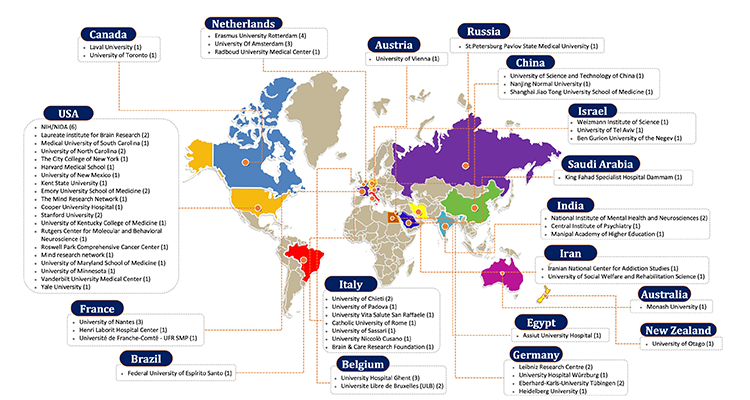
INTAM Membership Map
The international network has members from 17 different countries, including the United States, Canada, Australia, the United Kingdom, Spain, Italy, and Japan, among others. This diverse membership is crucial for INTAM's mission to provide a global platform for researchers to collaborate and share knowledge on non-invasive brain stimulation for substance use disorders.
JOINING INTAM
If you're interested in becoming a member of INTAM's global network and contributing to the advancement of non-invasive brain stimulation for substance use disorders, you can easily get started by sending an email to INTAM2018@gmail.com. In this email, you can express your interest in joining the network and provide any relevant information about your research or experience in the field. The INTAM team will review your application and get back to you as soon as possible with more information about how to become an official member of the network. Don't hesitate to reach out and join this growing community of experts and researchers dedicated to finding new solutions for addiction through cutting-edge neuroscience techniques.
The "Contact Us" section is a vital part of our website that allows visitors to easily reach out to us for any inquiries, questions, or feedback. You can contact us via email at INTAM2018@gmail.com and we will do our best to respond promptly. Additionally, you can follow us on Twitter at @INTAMnetwork to stay up-to-date on our latest news, events, and publications. We also encourage you to visit our YouTube channel, where you can find recordings of our webinars and other informative videos related to non-invasive brain stimulation for substance use disorders. We welcome all inquiries and feedback, and we are always happy to hear from those who share our passion for advancing this field.
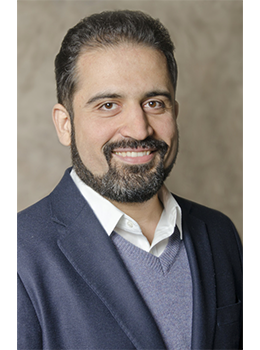
Co-Director
Hamed Ekhtiari, MD, PhD
Dr. Ekhtiari’s lab in University of Minnesota is focused to reshape the future of addiction treatment using brain imaging in combination with non-invasive brain stimulation technologies and cognitive training. Dr. Hamed Ekhtiari is the secretary of the Global Expert Network at the International Society for Addiction Medicine (ISAM GEN). Dr Ekhtiari also serves as the co-chair of the neuroscience section at the ISAM.

Executive Officer
Ghazaleh Soleimani, PhD
Dr. Ghazaleh Soleimani received her BSc in Electrical Engineering-Control and PhD in Biomedical Engineering from Amirkabir University of Technology (Tehran Polytechnic). She completed one-year postdoctoral research in a joint program of the Neurocognitive lab at Iranian National Center for Addiction Studies (INCAS) and the Cybernetic lab at Amirkabir University of Technology. She is now a postdoctoral scholar in Dr Hamed Ekhtiari’s lab, Department of Psychiatry and Behavioral Sciences, University of Minnesota. Her research is focused on the effects of transcranial electrical/magnetic stimulations (tES/TMS) on neural/behavioral outcomes in people with substance use disorders (SUDs) with the aim of opening new doors to therapeutic options in the field of addiction medicine and reshaping future of addiction treatment.
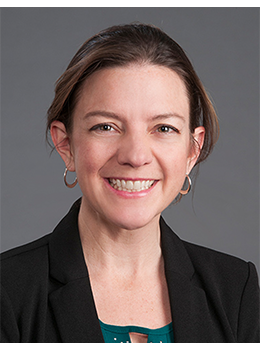
Co-Director
Colleen Hanlon, PhD
Dr. Hanlon has over 17 years of clinical research experience in TMS and brain imaging to this position. Dr. Colleen A. Hanlon has moved to BrainsWay as the Vice President of Medical Affairs since 2022. Before joining BrainsWay, she led multidisciplinary clinical research programs at the Medical University of South Carolina and Wake Forest School of Medicine. Recognized as a pioneering leader in the field, Dr. Hanlon received over $12 million in support from the National Institute of Health to develop neural-circuit based therapeutics for patients with a variety of psychiatric and neurologic disorders.
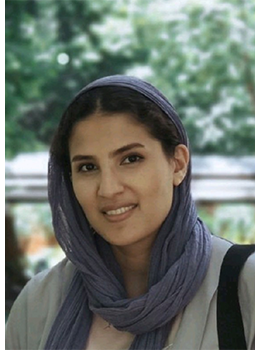
Executive Officer
Afra Souki, MSc
Afra is an early-stage researcher in cognitive neuroscience and neuroimaging. She graduated with a master's degree in Cognitive Neuroscience from the University of Tehran, Iran. She also completed a joint one-year Systems Neuroscience program at the Institute for Research in Fundamental Sciences (IPM) and the Sharif University of Technology. She studies how non-invasive brain stimulation affects brain activity and functional connectivity underlying behavioral changes in healthy and diseased individuals. Broadly, she is interested in Computational Psychiatry, which aims to optimize mental health diagnosis and treatment.
